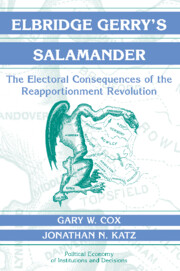Book contents
- Frontmatter
- Contents
- List of Tables and Figures
- Preface
- Part I Introduction
- Part II Democrats and Republicans
- Part III Incumbents and Challengers
- 8 The Growth of the Incumbency Advantage
- 9 Candidate Entry Decisions and the Incumbency Advantage
- 10 Redistricting and Electoral Coordination
- 11 Redistricting, the Probability of Securing a Majority, and Entry
- 12 Reassessing the Incumbency Advantage
- Part IV Conclusion
- References
- Author Index
- Subject Index
- Titles in the series
10 - Redistricting and Electoral Coordination
Published online by Cambridge University Press: 10 November 2009
- Frontmatter
- Contents
- List of Tables and Figures
- Preface
- Part I Introduction
- Part II Democrats and Republicans
- Part III Incumbents and Challengers
- 8 The Growth of the Incumbency Advantage
- 9 Candidate Entry Decisions and the Incumbency Advantage
- 10 Redistricting and Electoral Coordination
- 11 Redistricting, the Probability of Securing a Majority, and Entry
- 12 Reassessing the Incumbency Advantage
- Part IV Conclusion
- References
- Author Index
- Subject Index
- Titles in the series
Summary
In the previous chapter, we showed that conventional estimators overestimate the incumbency advantage. The positive correlation between the incumbent party's vote share and the presence of an incumbent candidate seeking reelection is due not only to the strength of the campaign that the incumbent candidate can mount (using the resources of her office) but also to the fact that incumbents who forecast sufficiently poor vote shares for their party, relative to their opportunity costs, withdraw from the race. Our findings also showed that the contribution of vote forecasting to the incumbency advantage as usually measured increased in the 1960s.
In this chapter, we seek to explain why incumbents' exits might have become more reliable signals that their party would fare poorly in the ensuing open-seat election. We note that the reapportionment revolution introduced unavoidable redistricting after every decennial census that candidates could more easily anticipate. This, in turn, meant that the next redistricting increasingly provided a focal point in the entry game between strong would-be challengers and sitting incumbents.
how anticipations of redistricting help coordinate entry
The Supreme Court's decision in Wesberry v. Sanders should have abruptly changed politicians' expectations regarding the frequency and inevitability of redistricting. Prior to Wesberry, redistrictings were virtually certain only in states that lost seats in the decennial reapportionment. In the other states, those that either held even or gained in the reapportionment, district lines were often preserved. After Wesberry, in contrast, everyone knew that redistrictings would occur at least once every 10 years. Moreover, virtually every district would be affected because population shifts over the decade would leave almost no districts close enough to the new statewide average to satisfy the court's equalpopulation mandate.
- Type
- Chapter
- Information
- Elbridge Gerry's SalamanderThe Electoral Consequences of the Reapportionment Revolution, pp. 162 - 171Publisher: Cambridge University PressPrint publication year: 2002



